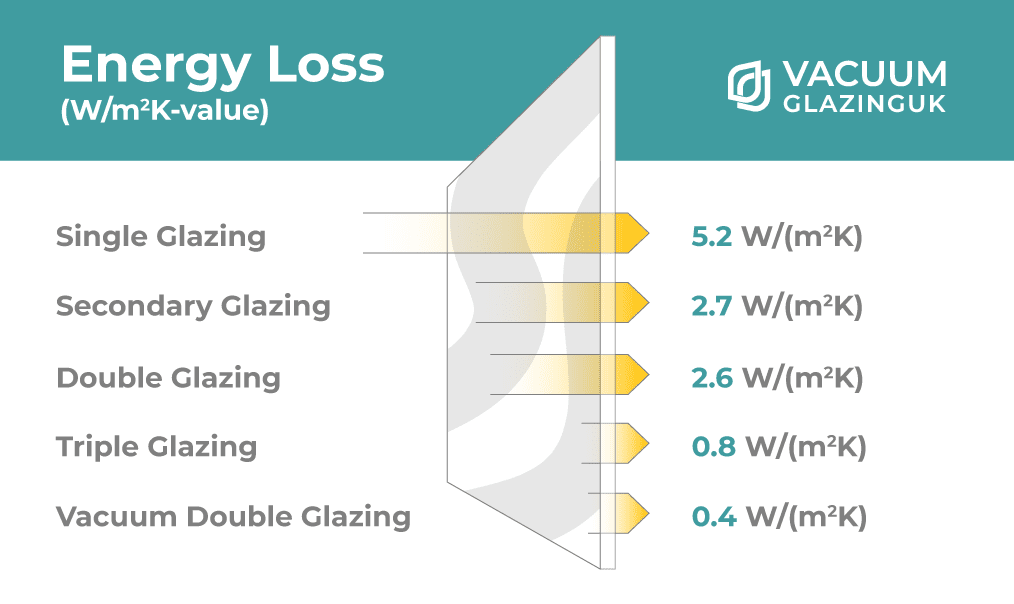
What is Vacuum Double Glazing?
What is vacuum double glazing? We explain how vacuum glass works and why you need it in your home.
Vacuum double glazing explained
Vacuum double glazing is a type of glass that has two panes separated by a vacuum cavity. It is also known as vacuum-insulated glazing or insulated glazing, and it’s primarily used in houses where owners want better insulation combined with improving the visual aspect of their homes. Vacuum double glazing helps reduce heat loss through windows because the vacuum between the panes acts as a highly efficient insulator.
Unfortunately, there are lots of myths and misinformation about vacuum double glazing that can make it seem like an unsuitable investment. To help you understand whether this type of glass is right for your property, we’ve compiled everything you need to know about vacuum double glazing, including the pros and cons, costs, insulation benefits, and installation tips.
How Standard Double Glazing Works
Standard double glazing is made of 2 panes of glass separated by a cavity filled with an inert or noble gas – usually argon. Noble or inert gas is denser than air, so heat and sound cannot cross it very easily. This reduced thermal conductivity gives the windows insulating properties. The insulating properties can be improved by using different types of glass with improved thermal properties.
The Problems with Standard Double Glazed Windows
Whilst double glazed windows are a vast improvement on the old single-glazed windows, they are not without their problems.
Firstly, the gap between the two panes of glass is anything from 14mm to 25mm. This means that the ugly inner frame is clearly visible, it’s not very nice looking and spoils the look of the windows.
This gap is especially problematic in heritage projects – the renovation of Listed buildings and those in conservation areas. In these window installations, it’s a requirement that that the replacement units look as much like the original windows as possible. In older buildings this means single glazing. Obviously, any home owner is going to want to improve the efficiency and comfort of their home. Single glazing may be prettier, but it allows most of the heat out of the rooms resulting in uncomfortable living conditions and higher heating bills.
There’s also the double image effect that two widely separated panes of glass give. This is unacceptable to planning officers when dealing with heritage projects.
Ultra slim double glazing was developed to help combat these problems. While these units somewhat satisfy the need for the appearance of single glazing (not entirely), they tend to fail around the seals because the upstands and seals are too slim. Some ultra slim double-glazing manufacturers have even taken to trading standard by the Glass and Glazing Federation (GGF https://www.ggf.org.uk/) because of the quality issues that are inherent in ultra slim double glazing.
How Vacuum Double Glazing Works
In vacuum double glazing, the cavity has all the air removed. Because heat and sound cannot cross a vacuum, this makes for a very efficient window with great insulation properties.
Because a vacuum has the same properties no matter if it’s .1mm or the vastness of space, the cavity between the two panes can be incredibly small and still have the same heat and sound-insulating properties.
What are the Benefits of Vacuum Double Glazing?
Vacuum double glazing offers a number of benefits compared to standard double-glazed windows. These include better thermal insulation and sound reduction, as well as improved looks and more chance of compliancy in heritage projects.
Vacuum double glazing helps reduce heat loss through windows because the vacuum between the panes acts as a super-efficient insulator. Because of the vacuum cavity, the glass has a lower U-value even than triple glazing, which means it insulates better.
Vacuum insulated glazing also reduces the amount of noise from outside, as sound cannot cross a vacuum.

Heat loss in window types compared
Who should install Vacuum Double Glazing?
Vacuum double glazing is a great option for most homes.
Heritage Windows
As mentioned above, vacuum glazing is particularly suitable for heritage projects. It’s slimline aspect give the impression of single glazing. This means that it can be approved for use in restoration projects by local planning authorities.
Passive House Builds
Vacuum glazing can be perfect for passive house builds – sometimes referred to as passivhous. The passive house movement promotes super-efficient buildings in order to combat climate change. One of the characteristics of a passive house is that it is very well sealed – there are no draughts and air movement is inhibited. This means that it takes very little energy to keep warm (or cool) as the temperature inside is kept consistent. Insulation is a major factor in passive house builds, and the super-efficient properties of vacuum glazing make it an obvious choice. In these properties, it is often required to add an additional pane of glass with a second more traditional cavity – this is to counter the relatively high thermal transmittance of the vacuum insulated glazing perimeter seal. Adding the additional layer can provide the opportunity to easily customise the unit to include anti-sun, laminated glazing or anything else required to balance security and energy efficiency.
Homes in Noisy Areas
Homes that are near busy roads, in cities or near other noisy areas such as airports or train lines will benefit from installing vacuum glazing. The noise-reducing properties will make these homes more comfortable and pleasant to live in.
Off-Grid and Energy Independent Homes
You may consider installing vacuum glazing if you are converting your home to off grid green energy – solar panels, heat pump and solar batteries. The increased efficiency of your home will help you get the most use of the energy you make at home and be less reliant on the expensive energy from the grid.
Is vacuum Double Glazing Worth the Cost?
In most cases, vacuum double glazing is a sound investment. It is often used in tandem with other forms of insulation and can help to reduce energy bills for the homeowner. In the current energy crisis (October 2022) vacuum glazing can help homeowners keep their bills down, especially when other improvements are made to insulate the property.
Vacuum double glazing is more expensive than standard double glazing, but most people feel that it’s worth it for the aesthetic improvements alone. It’s also worth considering that the metallic perimeter seal is much more resilient than a typical butyl seal on a double or triple glazed unit. The standard guarantee for a vacuum insulated unit is 15-years, compared to 10-years on other insulated unit, but the expectation is that the lifespan will be far longer. This makes a significant difference when you are assessing total life costs.
Conclusion
The vacuum-insulated glass used in vacuum double glazing is a great way to improve the energy efficiency of a home. It offers a number of benefits including reduced heat loss and improved sound reduction, and it can also help to improve the looks of a home. While vacuum double glazing is more expensive than standard double glazing, it also provides greater value thanks to its superior insulation properties and longer expected lifespan. Anyone can install vacuum double glazing, and it makes a great investment for any homeowner.